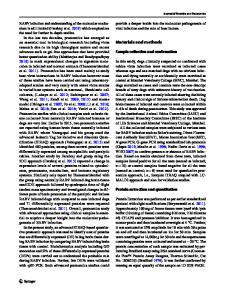Phylogenetic analysis of the whole genome sequence of a dog lineage rabies virus detected from cattle in eastern China,
- PDF / 566,640 Bytes
- 6 Pages / 595.276 x 790.866 pts Page_size
- 20 Downloads / 318 Views
VETERINARY MICROBIOLOGY - SHORT COMMUNICATION
Phylogenetic analysis of the whole genome sequence of a dog lineage rabies virus detected from cattle in eastern China, 2019 Kaihui Cheng 1 & Huimeng Chu 1 & Yachu Ren 1 & Xiaoli Xie 1 & Zhijun Yu 2 & Hongjun Yang 1 Received: 15 December 2019 / Accepted: 19 March 2020 # Sociedade Brasileira de Microbiologia 2020
Abstract Rabies is an important zoonosis worldwide, and this disease is caused by the rabies virus. Dogs and bat are the major hosts of rabies virus; however, many animals could infect with the rabies virus. By biting or scratching by an infected animal, rabies virus can be transmitted to cattle which is an important domestic animal in animal husbandry. Here, we report a case about a rabies virus (abbreviated JSTZ190314) found in cattle in eastern China in 2019. Our findings suggest that this rabies virus JSTZ190314 was a dog-origin rabies virus and belonged to the Asia clade. Furthermore, we found that this JSTZ190314-like rabies virus has been prevalent in China for more than 13 years and infected six species of animals. Our findings suggested that enhanced surveillance and research of rabies virus infection in bovine populations is needed. Keywords Rabies virus . Bovine . Dog . Eastern China . Phylogenetic analysis
Rabies is an important zoonosis caused by lyssaviruses (most often rabies virus), and rabies viruses can cause fatal disease in humans and other animals [16, 19]. Rabies virus could infect warm-blooded animals, including dogs [18], and it is noted that dog rabies has been abolished as a normal event in many countries. The effective control of dog rabies is seen as an important success in the struggle to limit rabies [15]. However, due to the rabies virus which can also be transmitted to other animals [5], including cattle, rabies remains a complex problem. Rabies virus infection of cattle can cause potential harm to animal husbandry and public health. The efforts to control rabies virus infection of cattle have been directed at vaccinating cattle in some countries for several decades [9]. Bovine rabies has been reported in many countries all over the world, but less in China [1, 9, 10, 14, 17]. Here, to enrich the genetic Kaihui Cheng and Hongjun Yang contributed equally to this work. Responsible Editor: Flavio Guimaraes Fonseca. * Zhijun Yu [email protected] 1
Dairy Cattle Research Center, Shandong Academy of Agricultural Sciences, Jinan, People’s Republic of China
2
Poultry Institute, Shandong Academy of Agricultural Sciences, Jinan, People’s Republic of China
information of rabies virus infection in animals in China and compare this viral genome sequence to genome sequences with those from other countries reported in GenBank, we report and make an evolutionary analysis of a dog lineage rabies virus detected from cattle in eastern China in 2019. In March 2019, a suspected rabies case in cattle was defined by clinical signs in a farm in Jiangsu province, eastern China. The clinical signs included howling, salivation, and eventually death
Data Loading...











